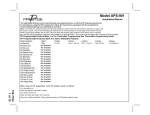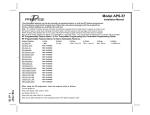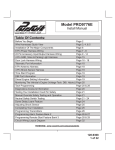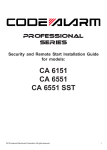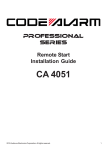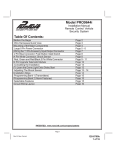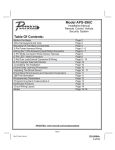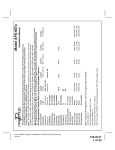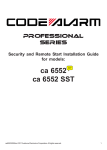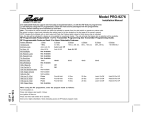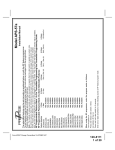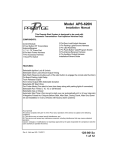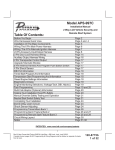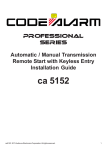Download Audiovox AS9076C Installation Manual
Transcript
Model PRO9233E TM Installation Manual Factory Keyless Entry Alarm Upgrade System SERIES Table Of Contents: Before You Begin Wire Harnesses Quick View Mounting Of The Major Components 14 Pin Accessory Input/Output Harness Wiring 2 Pin Door Lock/Unlock Connector & Wiring 5 Pin Arm/Disarm/Trunk Shunt Inputs 2 Pin LED / Valet Connectors Programming Alarm Feature Telematic Upgrade Port Information Completing Your Installation Dome Delay Learning Proceedure Adjusting The Shock Sensor Wire Dressing Circuit Wiring Layout Page 2 Page 3 Page 5 Page 5 - 7 Page 7 Page 7 - 8 Page 9 Page 9 - 11 Page 11 Page 11 Page 11 Page 11 Page 11 Page 12 PATENTED: www.voxxintl.com/company/patents Page 1 128-9324 1 of 12 Before You Begin PROFESSIONAL INSTALLATION IS STRONGLY RECOMMENDED Roll down window to avoid locking the keys in the vehicle during installation. Avoid mounting components or routing wires near hot surfaces or near moving parts like the steering wheel as it may prevent proper operation of the vehicle. Tape or loom wires under the hood and dash for protection as well appearance. Use grommets when routing wires through metal surfaces to prevent chafing and shorting. Use a Digital Multi Meter for testing and verifying circuits. DO NOT USE A "TEST LIGHT" OR "COMPUTER SAFE PROBE" as these can set off air bags or damage sensitive vehicle computers and electronics. For technical support go to www.prestigecarsecurity.com or call 1 800 225 6074 PATENTED: www.voxxintl.com/company/patents Page 2 128-9324 2 of 12 14 Pin Main Wiring Harness 1 2 3 4 5 6 7 8 9 10 11 12 13 14 Red White Red/White White/Black Purple Yellow Green/White Black/White Black Orange Brown LT. Green DK. Green Green/Black Part # 1123895 (+) 12 Volts Parking Light Input (+) Parking Light Output 15A Max + 12 Volt Module Input (+) Positive Siren Output Positive Door Trigger Input Ignition Input Switched +12 Volts Illumination Entry Output (-) 300mA Horn Output (-) 300mA Chassis Ground Ground Output While Armed (-) 300mA Negative Door Trigger Input Negative Trigger Input Zone 1 Negative Hood / Trunk Trigger Input Auxiliary Output (-) 300mA 5 Pin Arm/Disarm Trunk Shunt I/O Harness 1 2 3 4 5 Green/Black Red Green Red/Black Blue Arm 2 Input Disarm 1 Input Arm 1 Input Disarm 2 Input Trunk Shunt Input 2 Pin Door Lock Output Harness 1 2 Red Green Part #1123237 Part #1122242 Neg. Lock / Pos. Unlock 300mA Max Pos. Lock / Neg. Unlock 300mA Max. Page 3 128-9324 3 of 12 PRE - INSTALLATION NOTES : This system provides an output that is used to drive the siren, and an output that can pulse the vehicle's horn. When utilizing the horn, an additional relay maybe required. Caution: on many vehicles the factory horn is not designed for continuous use, and it is recommended that the siren is used for these vehicles. Check to see if the horn in the vehicle is the same part that is used in a vehicle with the factory installed security system STAND ALONE PASSIVE ALARM: When installing this unit as a stand alone passive alarm system, the following programmable features must be set: Feature #5 set to Passive. Feature #7 set to Delay. Feature #8 set to 1 Wire Disarm. IMPORTANT: In the entry delay mode, when the alarm is armed, the doors will trigger the alarm 15 seconds after the door is opened. IMPORTANT: THE ENTRY DELAY WILL NOT OPERATE WHEN THE VOLTAGE SENSING CIRCUIT, FEATURE # 6, IS ACTIVE AUXILIARY FUNCTION or REMOTE START OUTPUT: This system includes an additional transistorized ground output that can be used to trigger an external remote starter or remote window closure module. This is the Green w/Black trace wire, and it is activated by pressing the Lock, then Unlock, then Lock buttons on the factory transmitter within a 3 second time period. REMOTE PANIC: This system will allow the activation of remote panic using the factory transmitter. Pressing the Unlock, the Lock, then Unlock buttons on the factory transmitter within a 3 second time period will activate the remote panic feature. TRUNK SHUNT/TRIGGER BY - PASS INPUT: This system provides a positive trunk release input, which allows the activation of the remote trunk release from the OEM transmitter without triggering the alarm, even when the system is armed. VALET / MANUAL OVERRIDE SWITCH: This system provides a selectable manual override which, in the simple mode, is operable by first turning on the ignition switch then pressing the override pushbutton switch one time, or by a custom code override which is fully explained in the owners. The valet circuit is available only after the system is disarmed, then with the ignition on, press and hold the pushbutton LED switch until the LED turns On. UNDERSTANDING ARM & DISARM #1 AND #2: Because of the complexities of the different factory installed Remote Keyless Entry Units on the market today, this system uses two disarm and two arm inputs. Whether installing into a vehicle using a 2-step unlock circuit, single step unlock circuit, or as a stand alone passive alarm, both disarm and arm wires must be connected in all installations. The arm and disarm functions of this system are learned during power up, by monitoring the resting state of the factory wires when power is applied to the unit. Be certain all wires are connected to the vehicle before applying power to the circuit to insure the system responds only during operation from the factory transmitters. NOTE: By design, if feature #8 is set to the "1 WIRE DISARM" selection, the alarm will not disarm while the system is in the triggered mode. You will note in the feature selection table a selection for OR, and a selection for AND. In the OR configuration if either of the arm, or disarm wires have a state change, the circuit will invert and either arm or disarm. Page 4 128-9324 4 of 12 In the AND configuration, both wires must invert to have a state change at the alarm module to either arm or disarm. In the OR configuration a typical connection would be the Drivers Door Motor, and the Drivers Door Switch. This will allow the unit to arm from the factory keyless entry transmitter and not be armed or disarmed from the door switch. In the AND configuration, if there is no door switch available or it is inaccessible, you can connect to the drivers motor leg and the parking light which typically activates from the factory transmitter. In either case, the factory transmitter should allow the circuit to arm and disarm, however, the in vehicle door switch should not. Please confirm proper operation once the unit is installed. INSTALLATION OF MAJOR COMPONENTS ALARM CONTROL MODULE : P/N 1365420 Select a mounting location inside the passenger compartment ( up behind the dash ), and secure it using screws, or cable ties. Do not mount the control module in the engine compartment, as it is not waterproof. Do not mount the unit or route the wiring near the steering shaft, as it might become entangled preventing proper operation of the vehicle. PUSHBUTTON LED SWITCH: P/N PRLED Select a mounting location known and accessible to the operator of the vehicle. A dash knockout plug or front dash panel is desirable as the now Push-Button LED assembly needs the LED to be visible from the outside of the vehicle and will be used for valet modes, programming features, and for overriding the system unit when the vehicle is being serviced. Inspect behind the chosen location to insure that adequate clearance is allowed for the body of the switch, and also that the drill will not penetrate any existing factory wiring or fluid lines. Drill a 5/16" or 8mm hole in the desired location and mount the switch by passing the connectors, one at a time, through the panel from the front side and pressing on the bezel until the switch is fully seated. OPTIONAL SIREN: P/N AS9903E Select a mounting location in the engine compartment that is well protected from access below the vehicle. Avoid areas near high heat components or moving parts within the engine compartment. To prevent water retention, the flared end of the siren must be pointed downward when mounted. Mount the siren to the selected location using the screws and bracket provided. HOOD OR TRUNK PIN SWITCH: P/N 1363699 A pin switch is included for use in protecting the hood or trunk (or hatchback) of the vehicle. The switch must always be mounted to a grounded, metal surface of the vehicle. It is important to select a location where water cannot flow or collect, and to avoid all drip gutters on hood and trunk fender walls. Choose locations that are protected by rubber gaskets when the hood or trunk lid is closed. The pin switch can be mounted using an optional bracket, or direct mounted by drilling a ¼ “ diameter mounting hole. Keep in mind that when properly mounted, the plunger of the pin switch should depress at least ¼ “ when the hood or trunk lid is closed. WIRING THE SYSTEM 14 PIN MAIN WIRING HARNESS CONNECTOR P/N 1123895 RED FUSED WIRE: + 12 VDC CONSTANT BATTERY SOURCE In all installations, the RED wire will be connected to a + 12 VDC constant battery source. Connecting the Red wire not only supplies power to the on-board parking light relay, it also connects the Red/White module's power wire. WHITE WIRE : + 12 VDC PULSED PARKING LIGHT OUTPUT ( 15 A MAX ) This wire is provided to flash the vehicle’s parking lights. Connect the WHITE wire to the positive side of one of the vehicle’s parking lights. Page 5 128-9324 5 of 12 RED/WHITE : (+) 12 VOLT MODULE's POWER See RED Wire above. WHITE w/ BLACK TRACE WIRE : POSITIVE OUTPUT TO SIREN This is a + 12 VDC transistorized switched output when triggered. Connect this wire to the red, positive wire of the siren. Secure the black, ground wire of the siren to chassis ground. PURPLE WIRE : (+) DOOR TRIGGER If the vehicle’s door courtesy light switches have a + 12 VDC output when the door is opened (most Fords), you must connect this wire to the positive output from one of the door switches. Do not connect this wire at the illuminated entry output from the keyless entry module. You must connect this wire at the door ajar switch. In most cases, the PURPLE wire will only need to be connected to one door switch, no matter how many doors the vehicle has. IMPORTANT! Do not use the PURPLE wire if the vehicle has ground output type door switches. (See BROWN wire). NOTE: For vehicles with interior delay lighting see programming under title "Completing The Installation". YELLOW WIRE : + 12 VDC IGNITION SOURCE Connect this wire to a source that is + 12 VDC when the key is in the on and crank positions, and off when the key is in the off position. DARK GREEN w/ WHITE TRACE WIRE : ENTRY ILLUMINATION ( 300 mA MAX. ) The Dark Green w/ White Trace wire provides a 30 second ground signal whenever the system is disarmed using the OEM transmitter, and pulses ground when the alarm is triggered. It is used to provide the optional entry lighting feature and will flash the vehicle’s dome light when the alarm is sounding. This is a transistorized, low current output, and should only be used to drive an external relay coil. Connect the DARK GREEN w/ WHITE TRACE wire to terminal 86 of an external relay, connect terminal 85 of the relay to a fused + 12 VDC battery source, and wire the normally open and common relay contacts ( 87 and 30 ) according to the polarity of the vehicle’s courtesy light circuit. BLACK w /WHITE TRACE WIRE: LOW CURRENT HORN OUTPUT The black w/ white trace wire is provided to beep the vehicle’s horn. This is a transistorized low current output, and should only be connected to the low current ground output from the vehicle’s horn switch. If the vehicle uses a + 12 VDC horn switch, then connect the black w/ white trace wire to terminal 86 of the AS 9256 relay ( or an equivalent 30 Amp automotive relay ), and connect relay terminal 85 to a fused + 12 VDC battery source. Connect relay terminal 87 to the vehicle’s horn switch output, and connect relay terminal 30 to a fused + 12 VDC battery source. BLACK WIRE : CHASSIS GROUND Connect this wire to a clean, solid, unpainted, metal part of the vehicle’s chassis. ORANGE WIRE : GROUND OUTPUT WHEN ARMED This wire is provided to control the starter cut relay. Connect the ORANGE wire to terminal 86 of the relay, and wire the remaining relay contacts as shown in the wiring diagram. WARNING! Audiovox does not recommend using this relay to interrupt the ignition wire. Only connect this relay to the low current start solenoid feed wire, as indicated on the wiring diagram. BROWN WIRE : (-) DOOR TRIGGER If the vehicle’s door courtesy light switches have a negative ground output when the door is opened (most GM and Imports) you must connect this wire to the negative output from one of the door switches. Do not connect this wire at the illuminated entry output from the keyless entry module. You must connect this wire at the door ajar switch. In most cases, the BROWN wire will only need to be connected to one door switch, no matter how many doors the vehicle has. IMPORTANT! Do not use the BROWN wire if the vehicle has + 12 Volt output type door switches ( see PURPLE wire). NOTE: For vehicles with interior delay lighting see programming under title "Completing The Installation". Page 6 128-9324 6 of 12 LIGHT GREEN WIRE : (-) INSTANT TRIGGER ZONE 1 This is an instant activation ground trigger wire. This wire should be reserved for connection to optional ground output trigger devices such as motion, glass breakage and/or non plug in shock sensors. DARK GREEN WIRE : (-) INSTANT TRIGGER ZONE 2 This is an instant activation ground trigger wire. It should be connected to the previously installed hood and or trunk pin switches. GREEN w/BLACK TRACE WIRE : AUXILIARY OR REMOTE STARTER OUTPUT This wire provides a low current transistorized ground pulse to control the input trigger wire of a remote starter or window roll-up module. Connect this wire to the ground activated trigger input wire of the optional device. 2 PIN WHITE CONNECTOR : RED AND GREEN DOOR LOCK OUTPUTS (Auto Lock / Unlock) The door lock output wires from this unit will provide control for the passive lock feature as well as ignition controlled lock and unlock feature, and should be used only on vehicles whose Factory Keyless Entry circuits do not incorporate these features. These wires will provide either a pulsed ground output to the factory door lock control relay, or a pulsed +12 volt output to the factory door lock control relay. In either case, the maximum current draw through these outputs must not exceed 300 mA. 3 Wire Ground Switched Door Locks In this application, the red wire provides a ground pulse during the lock sequence. Connect the red wire to the wire that provides a low current ground signal from the factory door lock switch to the factory door lock control relay. The green wire provides a ground pulse during the unlock sequence. Connect the green wire to the wire that provides a low current ground signal from the factory door unlock switch to the factory door unlock control relay. 3 Wire Positive Switched Door Locks In this application, the red wire provides a positive pulse during the unlock sequence. Connect the red wire to the wire that provides a low current positive signal from the factory door unlock switch to the factory door unlock control relay. The green wire provides a positive pulse during the lock sequence. Connect the green wire to the wire that provides a low current positive signal from the factory door lock switch to the factory door lock control relay. 4 Wire Polarity Reversal and 5 Wire Alternating 12 Volt Door Lock Control Circuits In these applications, a Door Lock Interface (or equivalent 30 A automotive relays) must be used. Refer to the AUDIOVOX Door Lock Wiring Supplement for proper connection to these types of circuits and current model door lock interfaces to use. 5 PIN WHITE CONNECTOR: ARM/DISARM/TRUNK SHUNT INPUTS P/N 1123237 NOTE! When installing this system as a stand alone passive security system, the RED wire in this connector must be connected to a rest at ground, + 12 VDC switched ignition source. RED w/BLACK, GREEN & GREEN/BLACK wires must be connected to ground. The BLUE wire in this connector will not be required for the stand alone installation. The Green/Black, Red, Green, and Red/Black wires of the 5 pin connector are polarity learning inputs to be connected to the vehicle lock & unlock 1, and lock & unlock 2 control wires. When the control circuit is first powered up, these wires will learn the resting state of the circuits they are connected to. DO NOT operate the vehicle's door lock circuits, (switch or remote), while power is being applied to this upgrade alarm system. WIRING THE ARM / DISARM INPUTS IN VEHICLES WITH REMOTE 2 STEP UNLOCK,, FEATURE SELECTION 11 SET FOR OR The following represents the most common wiring routine in vehicles using the remote 2 step unlock feature. GREEN/BLACK WIRE : ARM INPUT #2 Connect this wire to the vehicles door lock switch input wire, which will receive either a switched positive or switched negative when the door lock switch is moved to the lock position. This wire will be used to compare Page 7 128-9324 7 of 12 the two inputs Arm #1 & Arm #2. If both inputs are active at the same time, the vehicle will not arm. The intent of this wire is to prevent the system from arming when the in vehicle door lock switch is used to lock the doors, insuring only the transmitter arms the system. If you do not desire this feature or the customer prefers that the door lock switch arm the system as well as the transmitter, connect this wire to chassis ground. RED WIRE : DISARM INPUT #1 Connect this wire to the driver's door unlock motor wire, which will receive a negative or positive pulse when the drivers door is unlocked with the remote transmitter, and the door switch, but does not receive a pulse when all doors are unlocked using the remote transmitter. GREEN WIRE : ARM INPUT #1 Connect this wire to the lock side of the door lock/unlock switch or, the driver's door lock motor leg wire, which will receive a negative or positive pulse when the doors are locked using the door switch or the remote transmitter. RED w/BLACK TRACE WIRE : DISARM INPUT #2 Connect this wire to the unlock side of the door lock/unlock switch or any passenger door unlock motor wire, which will receive a negative or positive pulse when all doors are unlocked using the door panel switch or the remote transmitter, but will not receive a pulse when the driver only door is unlocked using the remote transmitter. NOTE: The Green/Black/Red/ Green/& Red/Black wires MUST be connected to their respective source before powering up the module as these wire are polarity learn and will not function properly if connected after power up. In addition, these wires if not used as indicated above must be connected to ground. This will insure proper operation and prevent inadvertent arming and disarming when unintended. BLUE WIRE : TRUNK TRIGGER SHUNT INPUT This wire will determine if the vehicle’s trunk has been opened using the OEM transmitter, and prevent the alarm from triggering when the transmitter is used. This wire requires a positive trigger input and must be wired to the switched + 12 volt trunk control wire from the vehicle's keyless entry unit or, the switched + 12 volt side of the vehicle's trunk release solenoid. WIRING THE ARM / DISARM INPUTS IN VEHICLES WITH REMOTE FEATURE SELECTION 11 SET FOR AND This appllication is for vehicle's that have a 2nd unlock unavailable or difficult to access. GREEN/BLACK WIRE: ARM INPUT #2 Connect this wire to the vehicle's Parking light wire providing the parking lights are active when the transmitter is used to lock the vehicle doors. RED WIRE: DISARM INPUT #1 Connect this wire to the driver's door unlock motor wire, which will receive a negative or positive pulse when the drivers door is unlocked with the remote transmitter. GREEN WIRE : ARM INPUT #1 Connect this wire to the driver's door lock motor leg wire, which will receive a negative or positive pulse when the doors are locked using the the remote transmitter. RED w/BLACK TRACE WIRE : DISARM INPUT #2 Connect this wire to the vehicle's Parking light wire providing the parking lights are active when the transmitter is used to lock the vehicle doors. BLUE WIRE : TRUNK TRIGGER SHUNT INPUT Please follow information listed above for this wire connection and operation. Page 8 128-9324 8 of 12 WIRING THE ARM / DISARM INPUTS IN VEHICLES WHEN THE SYSTEM IS SET UP AS A STAND ALONE PASSIVE (IGNITION CONTROL) ALARM SYSTEM For this mode of operation, be certain to set selectable features #5 for passive, #7 for delay, and #8 for 1 wire disarm. GREEN/BLACK & GREEN WIRE: ARM INPUTS Connect these wires to chassis ground. RED WIRE : DISARM INPUT #1 Connect this wire to an ignition source that has +12 volts when the ignition switch is turned to the on and start positions and has 0 volts when the switch is in any other position. RED w/BLACK TRACE WIRE: DISARM INPUT #2 Connect this wire to chassis ground. BLUE: TRUNK SHUNT INPUT This wire is not used for the stand alone passive alarm application. VALET SWITCH: Plug the 2 pin connector from the push-button valet/LED switch into the mating 2 pin connector on the control module. LED: Plug the 2 pin connector from the push-button valet/LED switch into the mating 2 pin connector on the control module. PROGRAMMING (ALARM FEATURES): 1) Turn the ignition key to the on position. 2) Press and release the valet/programming switch 3 times (Siren Chirps). 3) Turn the ignition key off then on. (Siren Short Then long Chirp) 4) Press the pushbutton switch once to advance to feature 1, twice to advance to feature 2, etc,,,then use the lock button of the factory transmitter, or the lock switch on the door to select the feature setting. Example to set passive arming: 1) Turn the ignition key to the on position. 2) Press and release the valet/programming switch 3 times (Siren Chirps). 3) Turn the ignition key off then on. (Siren Short Then long Chirp) 4) Press the pushbutton switch six times to advance to features 6, Pass/Act Arm, then use the lock button of the transmitter to select two chirps "Passive Arm". 5) To exit the programming mode, turn the ignition key off. The program mode is automatically exited when there is no activity on the pushbutton switch or the factory transmitter or in vehicle lock switch. Page 9 128-9324 9 of 12 Page 10 128-9324 10 of 12 Feature Selection 1st DoorL/UL 2nd Accy Lock 3rd Accy. UL 4th Passive Locks 5th Pass/Act Arm 6th Door Trigger 7th 1 or 2 Wire Disarm 8th Siren/Horn 9th Horn Chirp 10th O/R Method 11th 14th L/UL Poll 1 Chirp 1 Sec. Auto Lock On Auto UL On Passive Passive Arm Instant 1 Wire Siren/Horn 10mS Custom Code 120mS XOR UL Dr & Pass 2 Chirps 3.5 Sec. Auto Lock Off Auto UL Off Active Active Arm Delay 2 Wire Siren Only 16mS Valet 80mS XOR UL Dr & Pass 40mS 80mS AND UL + Light 120mS AND UL + Light 4 Chirps Dbl L, 1Sec. UL Horn Only 30mS 3 Chirps 1Sec. L, Dbl. U/L RF Programmable Features Bank 2 Is Alarm Selectable Features: 50mS 5 Chirps Dbl L, Dbl UL 6 Chirps 1Sec. L/350mS ul RF Programmable Feature Bank 1 Is For Transmitter Programming See Transmitter Programming Guide. NOTE: Keyless Entry Models with no horn output will Flash the Parking Lights instead of chirp where chirp is indicated. Also, No data will be indicated if a feature is not available for a particular model. The unit will enter the feature but no selection will be available. Be certain to place a check mark indicating the method used in the box located on the last page of the owner's manual. NOTE : The method of manual override can either be selected to operate from the valet switch or operate by custom code. Custom Code programming is found in the owners guide Factory default settings are indicated by BOLD text. SELECTABLE FEATURES The selectable features of this unit can be set manually as explained on the previous page. NOTE: The program mode is exited if any of the following occur: a. 15 seconds of inactivity expire during any of the above steps. b. The ignition key is turned off. c. The push button switch is activated more than 12 times . The Siren/Horn will emit a long chirp followed by a short chirp indicating the program mode has been exited. 4 Pin Upgrade Telematic Module: Red = + 5 Volts Black = Ground White = Data TX Yellow = Data RX If used, connect the 4 pin harness from the Telematic one way module kit to the mating port on the controlling circuit. NOTE: If using the TWO WAY Telematic module, only Ground, TX, and RX are used on this port, the + 12 volt supply for the two way module must be sourced separately or the unit will not operate. 4 Pin Upgrade Data Bus/Flash Logic Module: If you are using an Audiovox Flash Logic module, it can be connected directly to the upgrade alarm system. Using the Blue 4 pin blue, red, black, & white harness and connect to the mating connector on the control module. Wire the Flash Logic/Data Bus module to the vehicle as prescribed in it's installation guide. COMPLETING THE INSTALLATION After all wire connections have been made, plug the main 14 pin connector into the control module. During the first few seconds of power up, the circuit's processor learns the resting state of the Red, Red/Black, Green and Green/Black wires of the 5 pin connector. It is important that the ignition switch be off, and the door lock/unlock switch or transmitter not be used during the power up sequence. Once this sequence is complete, you can disarm the system with the customers transmitter and move onto programming the selectable features. NOTE: This unit has the ability to learn the dome light delay time, up to 60 seconds. If the vehicle has delay interior lights, and you wish to avoid three chirp, defect zone, indication normally associated with this type of interior light, we suggest you learn the interior light delay. To learn the light delay, start with all doors closed: 1. Use the transmitter to Lock / Unlock / Lock / Unlock / Lock / Unlock / Lock, the system; The LED turns on solid to confirm the system entered the learn mode. 2. Immediately open and close the door of the vehicle to initiate the dome delay; The unit will monitor the door trigger input Positive, (Purple), and Negative, (Brown) when active. When the dome light turns off, the unit will add 2 seconds then exit the learn mode. 3. The LED will begin flashing the Armed indication indicating the unit has exited the learn mode and is armed Adjusting the Shock Sensor: P/N AS9492a If used, the sensitivity of the pre- etect circuit is automatically set 30% less sensitive than the full trigger circuit. Using a small screwdriver, gently turn the adjustment screw fully counterclockwise. (DO NOT over turn this screw. Maximum rotation for this adjustment is 270°). Close the hood and trunk lids, and arm the alarm. Wait 6 seconds for the accessories trigger zone to stabilize, then firmly strike the rear bumper with the side of a closed fist considering the amount of force required to break a window. WARNING ! Never perform this test on the vehicle’s glass, as you may break the window. Turn the adjustment screw clockwise (increasing sensitivity) about ¼ turn and re-test. Repeat this procedure until the alarm sounds. Ultimately, one firm strike to the rear bumper will cause the alarm to emit pre-detect warning tones. CAUTION: Setting the sensitivity too high can cause false alarms due to noise vibrations from passing trucks and heavy equipment. To decrease sensitivity, turn the adjustment screw counter clockwise. Wire Dressing: Always wrap the alarm wires in convoluted tubing, or with a spiral wrap of electrical tape. Secure these looms along the routing using cable ties. This will ensure that the alarm wires are not damaged by falling onto hot or sharp moving surfaces in the vehicle. Page 11 128-9324 11 of 12 Green/Black Red Green Red/Black Blue Arm2 Disarm 1 Arm 1 Disarm 2 Trunk Shunt PRO9233E To Optional One Or Two Way Telematic Module Pushbutton LED Assembly To FlashLogic Module When Being Used Red = (-) Lock (+) Unlock Red Green = (+) Lock (-) Unlock Green Red/White PRO9233E 15A Red (+) Black (Ground) Green (Full Trigger) Blue (Pre Detect) 5A To Shock Sensor (+) 12 Volt Supply To Parking Light Relay & Control Module Left Parking Lamp Red Right Parking Lamp Green/Black - - Auxiliary Output (-) 300mA Can Be Used For Remote Start Trunk Release Window Roll Up White Dark Green LT. Green To (+) Side Of Optional Siren White/Black Brown (-) Tigger Input Connect To Hood & or Trunk Pin Switch (-) Trigger Input Zone 1 Connect To Optional Negative Triggering Device (-) Negative Door Trigger Input Connect To Existing Door Pin Circuit In Vehicle Existing Low Current Start Solenoid Wire Cut (+) Positive Door Trigger Input Connect To Existing Door Pin Circuit In Vehicle Purple Orange (- Starter Inhibit Output) To Starter Motor X Black/White Black From Ignition Switch Start Terminal 30 Ignition Input Connect To + 12 Volts Ignition / Crank Yellow Black 87a 86 87 85 To + 12 Volt Ignition / Start Chassis Ground Green/White To Entry Illumination Wire Of Vehicle Black/White 87 87a 86 30 85 Black/White Low Current (-) Output To Operate Vehicle’s Horn Relay To Fused + 12 Volt Source Connect to (+) If Vehicle’s Interion Light Switched (+) Connect to (-) If Vehicle’s Interior Light Switched (-) ©2014 Voxx Electronics Corp., 150 Marcus Blvd. Hauppauge, N.Y. 11788 128-9324 Page 12 128-9324 12 of 12













